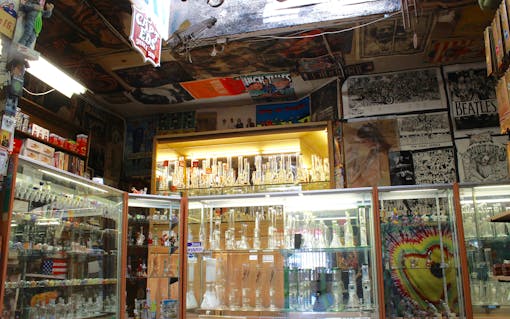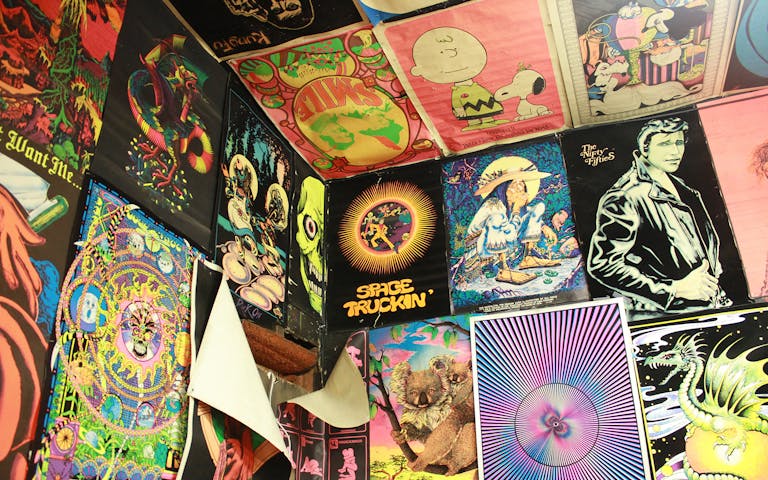Captain Ed’s on Van Nuys Blvd is the first head shop I ever stepped foot inside. The flagship store, owned and operated in the San Fernando Valley of Los Angeles, is a beautiful suburban relic adorned with murals and hippie ephemera. In the late 1980’s and early 90’s, I frequented the establishment for rolling papers and Graffix bongs. I recall more than one friend buying a proto pipe, a fashionable metal pipe that had a neat-o tool on it for cleaning and scraping resin. The second location on Reseda Blvd was my favorite place to get Grateful Dead stickers and patches when I wasn’t on the lot.
The shop, originally named Heads and Highs, turns 50 years old this year. The beloved icon of the valley continues to thrive, albeit discreetly in contrast to the wild counter-culture scene of its past.
In 1967, Bob Silverman and Edwin Marsh Adair III stumbled on the place. Bob’s son, Dee, runs the shops today, as both men have passed on. Their legacy lives in a well-staffed and stocked head shop, where the roots of the California marijuana legalization movement took hold.

In those golden days of the San Fernando Valley, Bob’s business sense guided the store while Ed’s heart attracted the community.
“They drove all the way to the valley when there were no freeways,” he recalled.“They got to the head shop, they walked in, and my Dad, who was kind of a hardcore business man, a young, really ambitious, working 60 to 70 hours a week kind of guy, looked around and said, ‘Holy crap, what would it take to open a place like this?’ The owner overhead them and said, ‘Why do you have to open one, this one’s for sale.’”
They had an epiphany that night, and bought the shop. Ed was soon working the counter five days a week, Bob on the weekends, and the culture detonated at what was ground zero, Heads and Highs.

Longer pipes started to evolve as bamboo bongs began to come out of Vietnam. It was in vogue to get lead out of rifles and guns and smoke weed in the chamber. “I remember there was no acrylic, no glass. I don’t even think there was metal yet, because metal pipes were made out of lamp parts,” Dee said.
Bob’s’s friend Maury Karp started Glasshead, a bong manufacturer in Vernon, Ca. Dee recalled visiting with his dad and pushing a shopping cart through “towering aisles of paraphernalia.” Karp’s dad, an immigrant with a thick accent, would total them up. Glasshead was a combination of glass and acrylic, and dominated the market until Graffix came along.
“You had the face of the shop as this true real authentic hippie soul, but you had the backbone of the shop as an authentic businessman...”
In those golden days of the San Fernando Valley, Bob’s business sense guided the store while Ed’s heart attracted the community. “Ed was a really benevolent, loving, welcoming person, had an amazing laugh, loved to get high obviously, loved to take acid, and loved the Grateful Dead. He was like exactly what you’d think he was, and then some. He was impossible not to like,” Dee shared.
Ed’s generosity earned him the name Captain Ed, in virtue of “O Captain! My Captain!” by Walt Whitman. A giving, selfless man, he believed passionately in the miracle of marijuana for medicine and industry. One day, Jack Herer walked in, just back from the Korean War where he was a military policeman. A super conservative, he had just smoked weed for the first time with a friend and had a transformational experience. Of course, he needed more papers and went to the local head shop. Ed was behind the counter.
A kismet moment, they connected immediately as Ed shared his views and struck Jack politically. They made a pact they would die trying to make pot legal, a milestone Jack witnessed but Ed did not, as the latter passed away first–but he had to feel the ripple in the universe. They were inseparable, and Jack went on to research and write The Emperor Wears No Clothes, the “seminal pro marijuana legalization manifesto,” as Dee called it.
Shop highly rated dispensaries near you
Showing you dispensaries near“Jack was a linguist who was well educated and did really extensive research to break the anti-pot mythology, to set the record straight,” he explained. “He was the one who started to talk about George Bush having hemp strings on his parachute in World War II. He talked about the founding fathers growing hemp, and the first time I ever heard those things were in Jack’s book.”
The men worked hard circulating petitions and made their mark in 1975 by working tirelessly campaigning to help lower penalties for pot possession.
All kinds of people hung out at the store, and the back room became an infamous hangout. “There was a waterbed in the blacklight room almost from the start and I mean, need I say more, I mean a lot of people got crabs in there back when venereal disease was incurable,” Dee said with a laugh.“It was like 24/7. I mean, the store was often not even closed at night, so there was a blacklight room with a waterbed in it, owned by dope smoking hippies. There you go, it’s exactly what you think.” The Reseda location opened in 1969, with a pinball arcade next door.

Dee shared, “In those days it was pretty much outside of the law to even exist, but it was enough of a gray area where they couldn’t absolutely shut you down. They could only make a lot of trouble for you. They busted the shop multiple times, cleaned the shelves off completely, and many stores went under after one or two busts. But we would re-open almost immediately. That’s why my Dad and Ed were really great partners, because my dad was a hardcore businessman and Ed was hardcore hippie. You had the face of the shop as this true real authentic hippie soul. but you had the backbone of the shop as an authentic businessman, and together it was made to be, and [those] two things are the reasons we survived.”
The shop changed its name in the 1980’s when Reagan came into office and the scene was forced into almost a more edgy subculture.
Products evolved as the culture figured out what it wanted. Graffix was game-changing with wider and taller bongs featuring metal pullstems. No one had ever seen pullstems like that before, and coupled with great branding, their joker skull, logo and the misspelling of“Graffix,” it was the must-have bong. Captain Ed’s carried a wide selection, and I went through several bongs of varying heights. I remember how happy I was when I got a four-foot clear Graffix bong, and the extra stickers that came with it when you bought it.
Bob Snodgrass emerged from the Grateful Dead family next with color-changing glass pipes, and by the mid 1990’s ROOR glass from Germany forever changed the bong retail scene, as their laboratory-grade glass created great bongs with a glass pullstem. Glass on glass meant a cleaner hit and a better high. Captain Ed’s was instrumental in carrying these products, and as glass took off, they invested heavily in turning the Reseda shop into a glass gallery, providing original one-of-a-kind art pieces for the heads.
The shop changed its name in the 1980’s when Reagan came into office and the scene was forced into almost a more edgy subculture. While the words that could be said inside a head shop became censored, Heads and Highs was renamed Captain Ed’s.
Walking into the shop today is an experience of those glorious old days. Vintage posters are all over the walls, though they were fresh as new paint the day they were hung. Aluminum can art, murals, magazine clippings, and early legalization posters mingle with images of the Grateful Dead and ‘60’s nudes. It’s nostalgic as ever, and you can get whatever you might need for smoking.
Dee honors his special life growing up in the shop with his Dad, Ed, Jack, and the other devoted customers, and he’s dedicated to preserving the shop’s value. “That’s the secret sauce, it’s authenticity with a business foundation,” he explained. “My goals for the shop are just to have the best customer service we can possibly provide, the coolest and most informed people behind the counter having even more business awareness and leading [customers] towards the best prices. And just, in essence, that you feel loved when you come in.”
Captain Ed’s and the Jack Herer family have joined forces to build the legendary Jack Herer Double Venturi pipes once again. They can be found at @jackhereroriginal on Instagram or JackHererOriginal@gmail.com.







